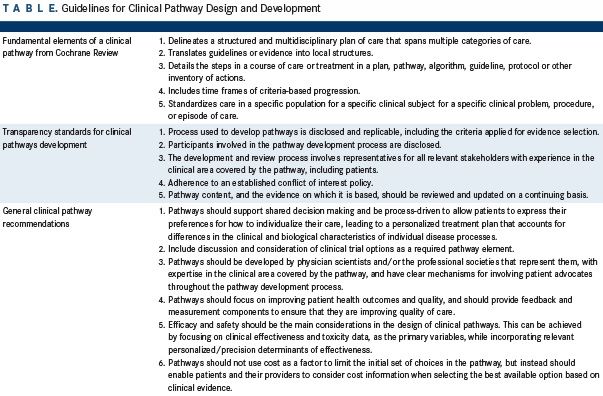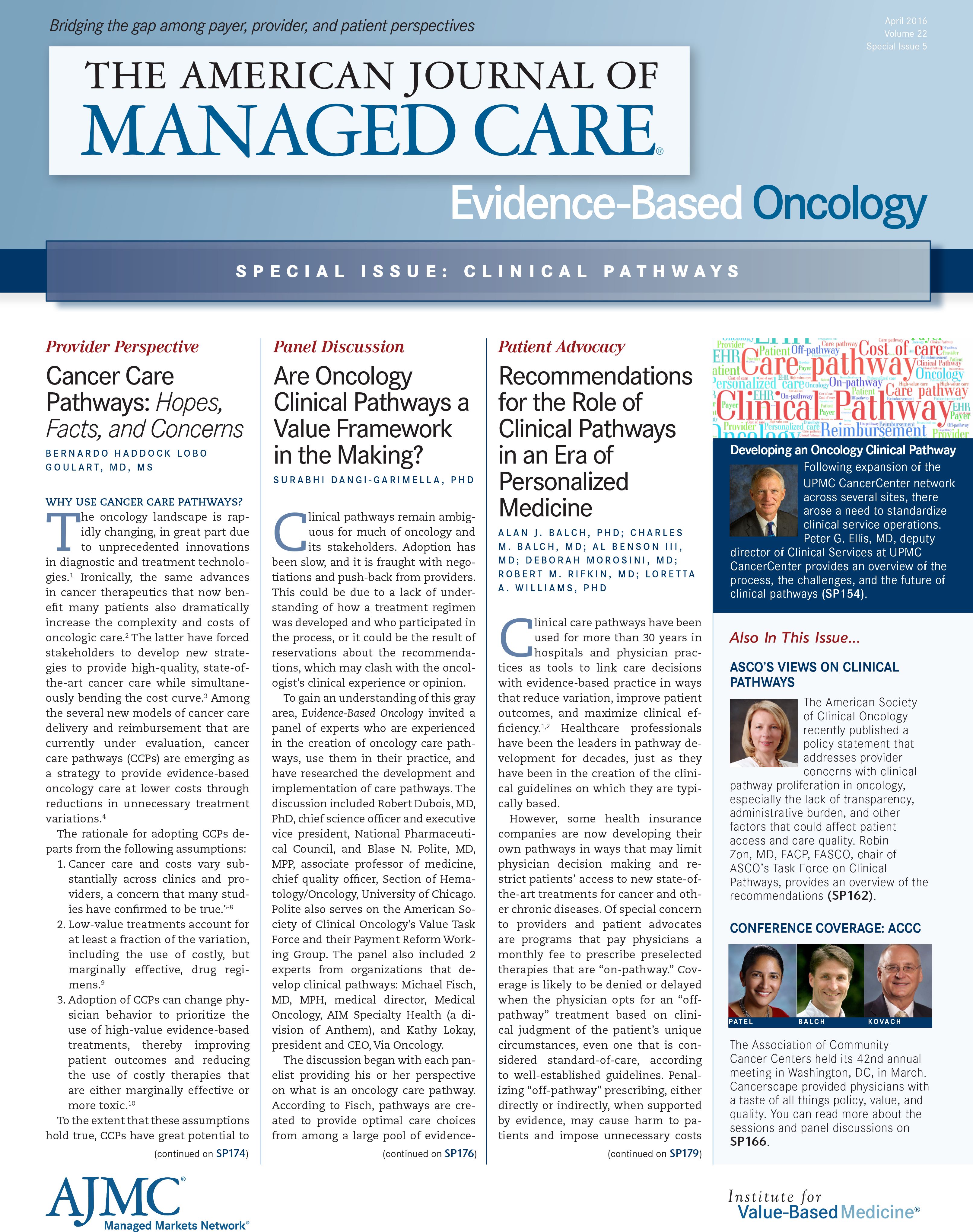- Center on Health Equity & Access
- Clinical
- Health Care Cost
- Health Care Delivery
- Insurance
- Policy
- Technology
- Value-Based Care
Recommendations for the Role of Clinical Pathways in an Era of Personalized Medicine
We offer recommendations for the development and design of clinical pathways in an effort to establish a set of normative criteria that creates trust and transparency.
Clinical care pathways have been used for more than 30 years in hospitals and physician practices as tools to link care decisions with evidence-based practice in ways that reduce variation, improve patient outcomes, and maximize clinical efficiency.1,2 Healthcare professionals have been the leaders in pathway development for decades, just as they have been in the creation of the clinical guidelines on which they are typically based.
However, some health insurance companies are now developing their own pathways in ways that may limit physician decision making and restrict patients’ access to new state-of-the-art treatments for cancer and other chronic diseases. Of special concern to providers and patient advocates are programs that pay physicians a monthly fee to prescribe preselected therapies that are “on-pathway.” Coverage is likely to be denied or delayed when the physician opts for an “off-pathway” treatment based on clinical judgment of the patient’s unique circumstances, even one that is considered standard-of-care, according to well-established guidelines. Penalizing “off-pathway” prescribing, either directly or indirectly, when supported by evidence, may cause harm to patients and impose unnecessary costs on the health system. Compounding the problem, the process, by which some clinical pathways are developed, is not transparent—providers and patients may not know why certain treatments are covered, what evidence was considered when creating pathway protocols, and whether their physician has a financial incentive to prescribe specific drugs.
We offer recommendations, in the following areas, in an effort to establish a set of normative criteria for the development and design of pathways that creates trust and transparency: the fundamental elements of a clinical pathway, the necessary transparency standards for their development, and the steps needed to ensure patients receive the best care in a shared-decision making context that reflects their physician’s clinical judgment.
What Are the Common Characteristics of a Pathway?
Ideally, clinical pathways should consist of a structured, multidisciplinary plan that details essential steps to improve continuity and coordination in the care of specific patients, and should span areas like diagnostics, surgery, nutrition, medications, and discharge planning.3 However, pathway programs in medical oncology often place a greater emphasis or focus on drug selection.
Table
In 2010, a team of Cochrane Review authors identified at least 5 characteristics () that define a clinical pathway from the literature that has subsequently been recognized as “a standardized, internationally accepted definition of a clinical pathway.”3 Clinical pathways are often developed and defined at the local or institutional level by the providers who are expected to implement them.4 This approach takes into account variations in the ways providers practice medicine within their local ecosystem to ensure that the needs of their patients are met.4 Some clinical pathways, however, are intended to standardize treatment protocols at a national, state, or regional scale to further reduce variations in the delivery of evidence-based care across sites, particularly in the absence of scientific merit for local variability in treatment regimens.5

Not All Pathways Are Created Equal
The healthcare community’s reaction to pathways has been mixed, particularly on the part of medical oncologists.4 Some resist it as a “cookie-cutter” approach that can interfere with personalizing a care plan to the individual.4 Others support it as an important tool for reducing errors and costs while increasing efficiency based on the best available evidence.6
A pathway program that is meant to drive coverage decisions for an individual patient treatment will operate differently from one that seeks to create quality at an aggregate level while maintaining flexibility and clinical judgment at the individual treatment level. The methods, by which the pathway is developed, and the preferred concepts on which it is based, are likely to differ when the program is driven by a group of providers as opposed to a payer.
Payers have a financial interest to place greater emphasis on cost control and pathway compliance in lieu of clinical judgment, than typically found in provider-sponsored pathways and guidelines. There exists a concerted and growing effort on the part of some health plans to either standardize pathways or create their own.7,8
Pathways can be designed as a comprehensive decision support tool that enables treating physicians to navigate their patients through various healthcare decisions—including clinical trials—based on different safety and effectiveness profiles, as well as cost considerations.2,6,9,10 On the other hand, a clinical pathway may serve to limit the need for clinical judgment and customization through rigid standardization based on the “average” patient. Some pathways, for example, consist solely of a pre-determined “checklist” of drug regimens from which the prescribing physician is financially incentivized to select for nearly all patients.8 Such a limited approach to a pathway more closely resembles common utilization management techniques like step therapy or “fail first” requirements that payers apply to regulate patient access to medications in an effort to control cost. Cost containment should not be the central organizing principle for clinical pathways.
Patient Access and Transparency
Some healthcare providers have expressed concern with the potential dilemma that might arise when the pressure to follow a payer’s limited set of predetermined pathway options conflicts with the provider’s clinical judgment about the best treatment option based on the individual’s unique circumstances.11 When providers elect to administer therapies that diverge from a payer’s clinical pathway, the latter is likely to deny coverage or require prior authorization and take time to review the provider’s chosen course of treatment regimen. Not only can such delays in physician-recommended treatment threaten patient health and impose unnecessary costs on the system, they also waste providers’ time, effort, and resources.
Patients place a sense of trust and mutual respect with their physician. This relationship must be protected from attempts to influence the physician’s treatment recommendations in the form of kickback arrangements to the practice by those who stand to benefit financially from the decision. Thus, there exists a growing concern among some physicians and patient advocacy groups regarding the use of payer-designed clinical pathways designed that include payments to physicians to induce the use of a narrow list of “on-pathway” therapies preselected by the payer.11 Such pay-to-prescribe incentives might short circuit the shared decision-making process and limit patient access to viable treatment options that are “off-pathway.”
We recommend that, at the very least, patients should have the right to know when their physician is participating in such a program. Patients need to be aware, not just of how options on pathways were chosen, but also of what other alternatives are viable, according to guidelines, that may not be listed in the pathway. Patients can then have an honest consultation with their physician about the various risks, benefits, and costs associated with each viable option. If reasonable clinical evidence exists to support one drug treatment regimen over others, based on what is going to provide the best approach for the patient, then healthcare professionals should be trusted to follow the evidence without an extra financial inducement to do so.
Providers Should Be Pathway Leaders
Pathway development should be owned and led by physician scientists and other members of the care team and/or the professional societies that represent them with specific expertise in the clinical area covered by the pathway. Clear mechanisms should exist for involving patient advocates throughout the pathway development process.
Table
Pathways should be evaluated against their ability to meet transparency standards such as those contained in the , that are consistent with those used by groups like the National Comprehensive Cancer Network, when developing clinical guidelines.
The providers who must live by the pathways are in the best position to determine how to translate guidelines into their institutional structures.12 Local design and control also helps prevent pressure to have multiple pathways from different sources deployed in the same provider ecosystem. Competing pathways within the same practice could lead to variability and inconsistency in the patient care experience, which are exactly the types of issues pathways are intended to reduce. For example, if multiple payers were to create different clinical pathways, then different patients with the same disease in the same hospital system might receive different care experiences based on their payer’s pathway.12
Conclusion
EBO
Pathway protocols should support shared decision making and patient preferences that lead to a personalized treatment plan that accounts for differences in the clinical and biological characteristics of individual disease processes. Discussion and consideration of clinical trial options should be a required pathway element. Efficacy and safety should be the main considerations in pathway design, while incorporating relevant personalized/precision determinants. The pathway process can navigate patients and providers through a cost discussion when selecting from among viable treatment options, and pathway programs should be measured against their ability to improve patient health outcomes and quality. Ultimately, clinical pathways should be a tool for optimizing treatment protocols by personalizing them for each patient in accordance with their physician’s clinical judgment. Isn’t that, after all, what medicine is all about?
Author information:
Alan J. Balch, PhD, chief executive officer, National Patient Advocate Foundation, Newport News, VA.
Charles M. Balch, MD, chair, Scientific Advisory Committee, National Patient Advocate Foundation; adjunct professor of Surgical Oncology, University of Texas MD Anderson Cancer Center, Houston, TX.
Al Benson III, MD, associate director for Clinical Investigations, Robert H. Lurie Comprehensive Cancer Center and Professor of Medicine, Northwestern University, Feinberg School of Medicine, Chicago, IL.
Deborah Morosini, MD, vice president, Clinical Development, Foundation Medicine, Boston MA.
Robert M. Rifkin, MD, associate chair for Hematology Research, US Oncology, Denver, CO.
Loretta A. Williams, PhD, assistant professor of Symptom Research, University of Texas MD Anderson Cancer Center, Houston, TX.
Address for correspondence:
Alan J. Balch, PhD
421 Butler Farm Rd
Hampton, VA 23666
E-mail: Alan.balch@patientadvocate.org
References
- Rotter T, Kinsman L, James E, et al. Clinical pathways: effects on professional practice, patient outcomes, length of stay and hospital costs. Cochrane Database Syst Rev. 2010;(3):CD006632. doi:10.1002/14651858.CD006632.pub2.
- Kinsman L, Rotter T, James E, Snow P, Willis J. What is a clinical pathway? Development of a defnition to inform the debate. BMC Med. 2010;8:31. 1. doi:10.1186/1741-7015-8-31.
- Li W, Liu K, Yang H, Yu C. Integrated clinical pathway management for medical quality improvement—based on a semiotically inspired systems architecture. European J Info Syst. 2014;23(4):400-417. doi:10.1057/ejis.2013.9.
- Gemse D, Wiseman M. Strategic use of clinical pathways. J Oncol Pract. 2011;7(1):54-56. doi:10.1200/JOP.2010.000193.
- Mamula K. Highmark chooses P4 Healthcare to develop cancer treatment protocols. Pittsburgh Business Times website. http://www.bizjournals.com/pittsburgh/print-edition/2010/11/19/highmark-p4-healthcare-cancer-treatment.html. Published November 19, 2010. Accessed March 7, 2015.
- Ellis PG. Development and implementation of oncology care pathways in an integrated care network: the Via Oncology pathways experience. J Oncol Pract. 2013;9(3):171-173. doi:10.1200/JOP.2013.001020.
- Gebhart F. Oncology benefit management undergoing a revolution. Formulary Journal website. http://formularyjournal.modernmedicine.com/formulary-journal/news/clinical/clinical-pharmacology/oncology-benefit-management-undergoing-evoluti?page=full. Published January 1, 2011. Accessed March 3, 2016.
- Nelson R. WellPoint offers oncologists incentives to follow pathways. Medscape website. http://www.medscape.com/viewarticle/826681. Published June 12, 2014. Accessed March 3, 2016.
- Hoverman JR, Klein I, Harrison DW, et al. Opening the black box: the impact of an oncology management program consisting of level I pathways and an outbound nurse call system. J Oncol Pract. 2014;10(1):63-67. doi:10.1200/JOP.2013.001210.
- Neubauer MA, Hoverman JR, Kolodziej M, et al. Cost effectiveness of evidence-based treatment guidelines for the treatment of non—small-cell lung cancer in the community setting. J Oncol Pract. 2010;6(1):12-18. doi:10.1200/JOP.091058.
- ANCO comments sent to Jennifer Malin, MD, Anthem Blue Cross medical director for oncology. Association of Northern California Oncologists website. http://www.anco-online.org/WellpointComments.pdf. Accessed March 3, 2016.
- Farina K. Forging a pathway to quality cancer care. Am J Manag Care. 2012;18(SP3):SP116-SP118.


